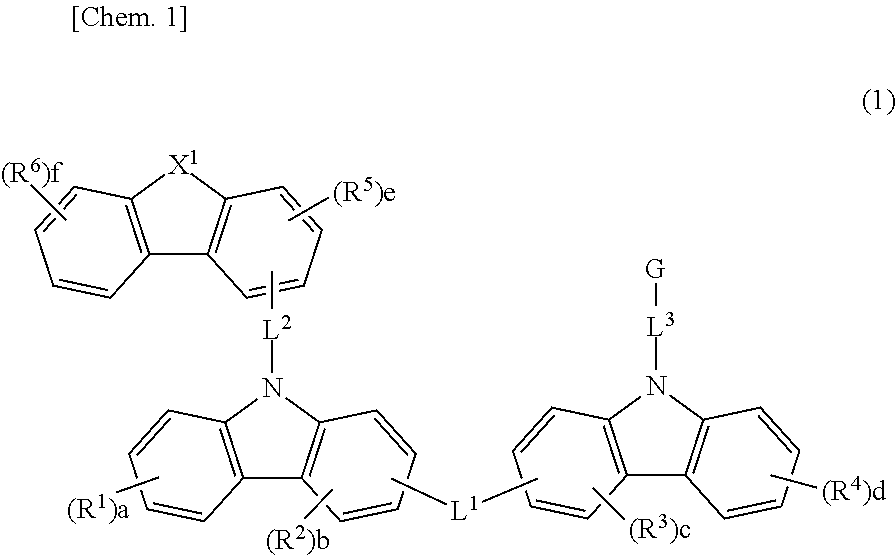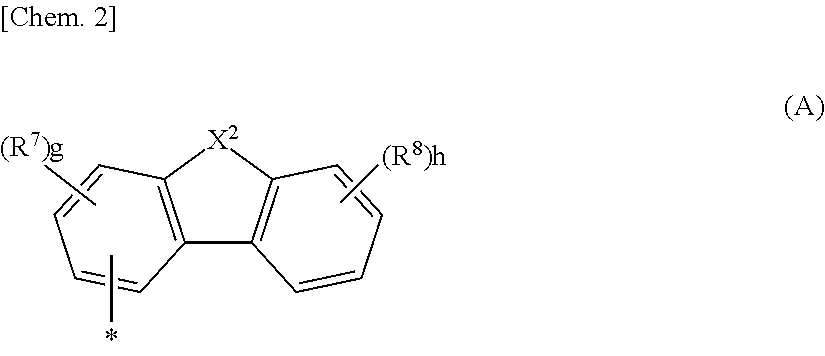Material for organic electroluminescent element, and organic electroluminescent element using same
a technology of electroluminescent elements and materials, applied in the direction of luminescent compositions, organic compounds, group 5/15 element groups, etc., can solve the problems of carbazole skeletons, no literature on carbazole skeletons, and difficult to achieve high efficiency and a long lifetime. achieve the effect of long lifetime and high efficiency
- Summary
- Abstract
- Description
- Claims
- Application Information
AI Technical Summary
Benefits of technology
Problems solved by technology
Method used
Image
Examples
synthesis example 1
Synthesis of Compound (1)
(1) Synthesis of Compound (1-1)
[0240]
[0241]49.22 Grams (200 mmol) of 3-bromocarbazole, 63.17 g (220 mmol) of 9-phenylcarbazole-3-boronic acid, a 2-M aqueous solution of sodium carbonate (200 ml), and 400 ml of 1,2-dimethoxyethane were loaded into a three-necked flask. Next, 2.31 g (2 mmol) of Pd(PPh3)4 were added to the mixture and then the whole was refluxed under a nitrogen atmosphere for 24 hours.
[0242]After the completion of the reaction, the sample was transferred to a separating funnel and extracted with dichloromethane several times. The resultant was dried with anhydrous magnesium sulfate, and was then filtered and concentrated. The concentrate was purified by silica gel chromatography (dichloromethane:hexane=6:4), and was then washed by being dispersed in methanol. Thus, a white solid (Compound (1-1)) was obtained.
[0243]Identification was performed by 1H-NMR and molecular weight measurement based on FD / MS.
Product amount: 50.6 g
Yield: 62%
(2) Synthesi...
synthesis example 2
Synthesis of Compound (70)
[0248]
[0249]3.32 Grams (10 mmol) of 3,3′-bicarbazole, 6.32 g (24 mmol) of 2-bromodibenzothiophene, 3.84 g (40 mmol) of sodium tert-butoxide, 137 mg (0.15 mmol) of Pd2(dba)3, 0.3 ml (0.6 mmol) of a solution of tri-tert-butylphosphine in toluene (2.0 M), and 40 ml of toluene were loaded into a three-necked flask, and then the mixture was refluxed under a nitrogen atmosphere for 24 hours.
[0250]After the completion of the reaction, 500 ml of toluene were added to the sample solution and then the mixture was refluxed in a stream of nitrogen for 1 hour. After that, the resultant was cooled to room temperature and then filtered by being passed through Celite. The filtrate was further passed through a silica gel short column. Thus, a raw material impurity component was removed. After that, the remainder was recrystallized with ethyl acetate twice. Thus, a pale brownish solid (Compound (70)) was obtained. It should be noted that the molecular weight of Compound (70)...
synthesis example 3
Synthesis of Compound (85)
(1) Synthesis of Compound (85-1)
[0252]
[0253]48.1 Grams (240 mmol) of 4,4′-diaminodiphenylether, 149.4 g (528 mmol) of 2-bromoiodobenzene, 92.3 g (960 mmol) of sodium tert-butoxide, 2.2 g (2.4 mmol) of Pd2(dba)3, 2.66 g (4.8 mmol) of 1,1′-Bis(diphenylphosphino)ferrocene, and 960 ml of toluene were loaded into a three-necked flask, and then the mixture was stirred under heat under a nitrogen atmosphere at 80° C. for 8 hours.
[0254]After the completion of the reaction, 500 ml of water were added to the sample solution, and then the mixture was transferred to a separating funnel and extracted with ethyl acetate several times. The resultant was dried with anhydrous magnesium sulfate, and was then filtered and concentrated. The concentrate was purified by silica gel chromatography (toluene:hexane=3:7). Thus, a colorless viscous body (Compound (85-1)) was obtained.
[0255]Identification was performed by 1H-NMR and molecular weight measurement based on FD / MS.
Product a...
PUM
| Property | Measurement | Unit |
|---|---|---|
| triplet energy | aaaaa | aaaaa |
| temperature | aaaaa | aaaaa |
| temperature | aaaaa | aaaaa |
Abstract
Description
Claims
Application Information
 Login to View More
Login to View More - R&D
- Intellectual Property
- Life Sciences
- Materials
- Tech Scout
- Unparalleled Data Quality
- Higher Quality Content
- 60% Fewer Hallucinations
Browse by: Latest US Patents, China's latest patents, Technical Efficacy Thesaurus, Application Domain, Technology Topic, Popular Technical Reports.
© 2025 PatSnap. All rights reserved.Legal|Privacy policy|Modern Slavery Act Transparency Statement|Sitemap|About US| Contact US: help@patsnap.com



